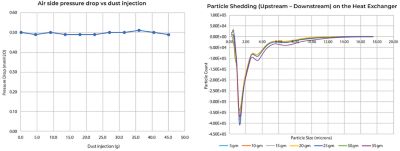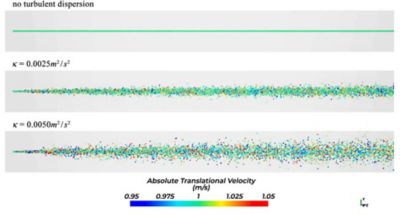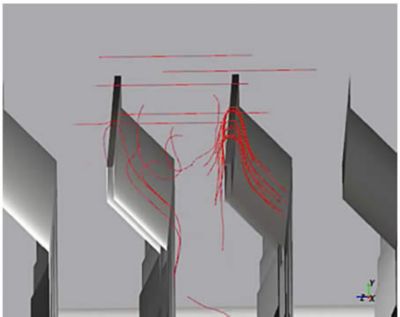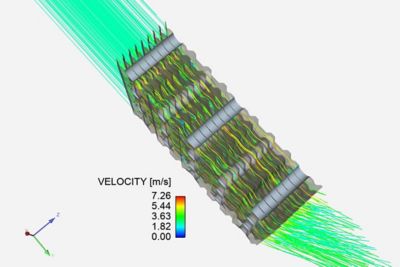-
-
Kostenlose Software für Studierende
Ansys unterstützt die nächste Generation von Ingenieur*innen
Studenten erhalten kostenlosen Zugang zu erstklassiger Simulationssoftware.
-
Verbinden Sie sich jetzt mit Ansys!
Gestalten Sie Ihre Zukunft
Stellen Sie eine Verbindung mit Ansys her, um zu erfahren, wie Simulation Ihren nächsten Durchbruch vorantreiben kann.
Länder und Regionen
Kostenlose Demoversionen
Produkte & Dienstleistungen
Lernportal
Über das Unternehmen
Back
Produkte & Dienstleistungen
Back
Lernportal
Ansys unterstützt die nächste Generation von Ingenieur*innen
Studenten erhalten kostenlosen Zugang zu erstklassiger Simulationssoftware.
Back
Über das Unternehmen
Gestalten Sie Ihre Zukunft
Stellen Sie eine Verbindung mit Ansys her, um zu erfahren, wie Simulation Ihren nächsten Durchbruch vorantreiben kann.
Kostenlose Demoversionen
ANSYS ADVANTAGE MAGAZINE
DATE: 2020
Custom Fitting a Solution for Custom-Fit Kitchen Appliances
By Anderson Bortoletto
Principal Engineer Advanced Product Group Sub-Zero Group Inc. Madison, U.S.A.
High-end kitchen designs camouflage appliances within their luxurious facades, restricting air flow and trapping dust and dirt. Coupled CFD–DEM is being used to investigate dirt accumulation.
Built-in appliances fill today’s high-end kitchens, in which seamless integration with cabinetry can pose technical challenges related to airflow restriction in a machine’s compartment. This problem is exacerbated by dirt accumulation on the condenser (heat exchanger), which can affect appliance performance.
Experimental evaluation of dirt accumulation on condensers is time-consuming and expensive. Consequently, Sub-Zero is coupling computational fluid dynamics (CFD) and discrete element modeling (DEM) to quickly gain insight on the mechanisms behind dirt accumulation in an effort to design a more robust heat exchanger.
Compared to bench-top component-level testing, overall foulant simulation can produce savings of up to 10% of total development costs — along with reduced time to market.
Sub-Zero, which began producing commercial freezer units three-quarters of a century ago, has re-imagined residential refrigeration with units built to last 20-plus years. Where the family kitchen once held a big, bulky appliance, today’s luxury home sports smaller, custom-fit modules that locate refrigeration where it makes the most sense — with options from freezers to ice makers to wine/beverage centers.
From an engineering standpoint, camouflaged refrigerators wrapped in cabinetry that hinders air flow is an ill-fated scenario for a component meant to remove heat. Add fiber (pet hair, lint, etc.), dust and grease accumulation at inaccessible sites, and you’ve created an ideal recipe for failure.
Foulant as a Recipe
One of the first steps in Sub-Zero’s heat exchanger investigation was figuring out how to define and represent relevant airborne materials, collectively referred to as foulant. At the time, the research team had been using CFD to model simple spherical dust specks within an air stream, but needed to include non-spherical dirt particles, high-aspect-ratio hair, and flexible fibers like cotton. These require DEM software, which offers accurate particle physics to predict behavior in a reasonable solve time.
The company’s engineers chose Rocky DEM for its ability to accurately model the foulant recipe, speed up computations using multiple graphics processing units (GPUs), and seamlessly integrate with the company’s Ansys multiphysics simulation portfolio. The team initially used Ansys CFD to model the heat exchanger’s fluid flow, which affects overall efficiency. DEM would yield information on particle deposition, fluid forces acting on particles, such as drag, and adhesion forces, ultimately assessing how the heat exchanger design affects particle behavior.
Figure 1. Experimental results proved that one-way coupling would be sufficient for accurate simulation results, simplifying the analysis. Left: air-side pressure drop following dust injection; right: particle shedding over time
One-way Street?
Originally, the team theorized that the simulation project would require a two-way coupled CFD–DEM approach, with Ansys Workbench as the main platform. In theory, dirt accumulation over time would affect airflow around the heat exchanger, causing foulant to build up even further and eventually affecting efficiency. If the change in efficiency was large, performing a two-way analysis would enable modeling the effect of the foulant on fluid flow and the effect of fluid flow on foulant deposition. However, in this case, the effect of the foulant on fluid flow was small enough to be considered negligible, as physical experiments showed.
A physical wind-tunnel experiment tested air-side pressure drop across a heat exchange sample as particles (dust + 5% cotton-linter fibers) were injected (figure 1). The test also studied the component’s ability to transfer heat during foulant accumulation and subsequent particle shedding. Results revealed minimal changes in pressure drop and heat transfer. As to particle deposition, once deposition reaches a specific value, airflow is sufficient to shed particles, stopping further accumulation.
Figure 2. Particle movement is smooth and uninterrupted when there is nothing to interrupt air flow (top). Running turbulent dispersion in the Fluent–Rocky simulation ensures naturally occurring vortexes and eddies, which randomly arise and ebb.
Though experiments are cumbersome and expensive, they sometimes provide insight that can help to simplify a modeling approach, as testing did in this case. In a different situation, a greasy or oily heat exchanger might exhibit greater particle adhesion, requiring two-way coupling, thereby lengthening and complicating the analysis process. Bench testing provided the confidence needed to proceed with one-way CFD–DEM simulation.
Physics Food for Thought
The engineering team leveraged the capabilities of a coupled Ansys Fluent–Rocky DEM solution to predict adhesion forces on high-aspect-ratio cotton-linter fibers, modeling electrostatic forces using Rocky’s adhesion model. The Coulomb force — exerted by stationary objects bearing electric charge on other stationary objects bearing electric charge — is turned on when particles
move closer than the adhesive distance. The force was set up to apply to particle–boundary, particle–particle, fiber–fiber and fiber–dust contact.
Figure 2. Particle movement is smooth and uninterrupted when there is nothing to interrupt air flow (top). Running turbulent dispersion in the Fluent–Rocky simulation ensures naturally occurring vortexes and eddies, which randomly arise and ebb.
Because airflow within the heat exchanger is nonuniform and particles are small, it was critical to instruct Fluent to run turbulent dispersion, duplicating real element behavior in the Rocky model (figure 2). Without it, simulation results produce an average flow field for every time step instead of naturally occurring turbulence. In reality, an area that blocks circulation (the wake of a tube, for example) produces near-zero recirculation velocity; though most particles are drawn to a higher-velocity region, specks that flow to this zone will accumulate. Therefore, fluctuating velocity — discrete piece-wise constant functions of time, computed according to the local turbulence field (turbulent kinetic energy and dissipation) — is added to the average fluid velocity: uƒ - ūƒ + úƒ in which total velocity (uƒ) equals the average velocity from Fluent’s flow field (ūƒ) plus fluctuating velocity (úƒ), which captures drag force that affects very tiny particles in the wake of edges.
Rocky has built-in capabilities to realistically model fibrous materials. The software utilizes a sphero-cylinder element joined by virtual bonds. Users can adjust flexibility by controlling the Young’s modulus (YM) ratio (figure 3), producing linear and angular bond deformation as well as forces and moments on adjacent elements to resist normal, tangential, bending and torsional deformations. Unfortunately, there is negligible literature on pet or human hair flexibility parameters, so experiments were conducted to calibrate the exact YM ratio.
Figure 4. Ansys Fluent velocity simulation results.
A CFD hexahedral mesh contained 7.02 million flow-aligned cells, a smaller number of elements than tetrahedral meshing would require yet fine enough to capture a viscous sublayer. It incorporated Y+ for the SST turbulence k-w model. The Fluent model was simulated in a transient run using air as a compressible fluid phase. Average velocity and pressure fields were exported to Rocky for one-way coupled simulation (figure 4).
Rocky DEM computed drag force per particle using Schiller and Naumann drag laws for spheres and the Marheineke and Wegener drag model for fibers. The simulation included continuous particle injection with random orientation.
Coupled simulation results showed that introducing turbulence dispersion to the computation increases the number of collisions between particles and walls — and intensifies dust and fiber accumulation. Adhesion force played a major role as well: The higher the adhesion force, the more mass that is deposited.
Sub-Zero’s future efforts include validating these simulation results with wind-tunnel testing. The process will form the framework for modeling particle accumulation on proposed heat exchanger concepts. It is critical that the Sub-Zero team gains insight about foulant movement and deposition to enable kitchen designers to exercise full creativity. For example, a component with large leading edges (like current heat exchangers) holds more surface area that can catch dirt. A heat exchanger located at the bottom of the refrigerator captures larger dust particles due to gravitational effects.
A macro view of the non-spherical dirt particles and fibers that foul condensers
How does an R&D team develop a better refrigerator design, one that is robust to dirt accumulation, based on particle flow discoveries?
Fluent and Rocky DEM can greatly assist Sub-Zero in this effort. This real physics technology provides amazing insight without the cost of excessive physical experiments. Compared to bench-top component-level testing, overall foulant simulation (once the framework is set in place) can produce savings of up to 10% of total development costs — along with reduced time to market, since results are available in a week, compared to months. The greatest savings will be seen on long-term testing programs that deploy prototypes in the field.
Los geht's
Wenn Sie mit technischen Herausforderungen konfrontiert sind, ist unser Team für Sie da. Mit unserer langjährigen Erfahrung und unserem Engagement für Innovation laden wir Sie ein, sich an uns zu wenden. Lassen Sie uns zusammenarbeiten, um Ihre technischen Hindernisse in Chancen für Wachstum und Erfolg zu verwandeln. Kontaktieren Sie uns noch heute, um das Gespräch zu beginnen.





